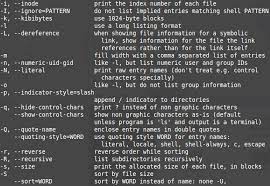Exploring the Exciting Features of the Latest Linux Updates
The Latest in Linux: Keeping Up with the Open-Source Revolution
Linux, the renowned open-source operating system, continues to evolve and innovate with each new release. The latest updates bring exciting features, enhanced security measures, and improved performance to users worldwide.
Enhanced Security
One of the key focuses of the latest Linux releases is bolstering security measures to protect users from potential threats. With built-in security features such as secure booting, sandboxing applications, and improved access controls, Linux provides a robust defence against cyber attacks.
Performance Improvements
Performance enhancements are a hallmark of the latest Linux updates. From optimised resource management to faster boot times and smoother multitasking capabilities, users can expect a more efficient computing experience with each new release.
New Features and Functionality
Linux is constantly pushing boundaries with new features and functionality that cater to a diverse range of user needs. Whether it’s improved compatibility with hardware devices, expanded software support, or intuitive user interfaces, the latest Linux updates strive to enhance user experience across the board.
Community Collaboration
The strength of Linux lies in its vibrant community of developers, enthusiasts, and users who collaborate to drive innovation forward. Through open communication channels and collaborative projects, the Linux community continues to shape the future of open-source technology.
Getting Started with Linux
For those looking to dive into the world of Linux or upgrade to the latest version, getting started is easier than ever. With comprehensive documentation, user-friendly interfaces, and extensive online resources, transitioning to Linux has never been more accessible.
Top 9 Advantages of the Latest Linux: Security, Performance, and More
- Enhanced security features protect users from cyber threats.
- Improved performance for faster boot times and smoother multitasking.
- Regular updates ensure access to the latest software and features.
- Extensive hardware compatibility allows for seamless integration with devices.
- Customisable user interfaces cater to individual preferences and workflows.
- Open-source nature fosters innovation and community collaboration.
- Robust package management system simplifies software installation and updates.
- Strong focus on privacy and data protection enhances user security.
- Cost-effective alternative to proprietary operating systems with no licensing fees.
Challenges of Adopting the Latest Linux: Key Drawbacks to Consider
- Steep learning curve for beginners unfamiliar with Linux
- Limited support for certain proprietary software applications
- Potential compatibility issues with specific hardware configurations
- Occasional software bugs or glitches in new releases
- Complexity of system configuration and customisation may be overwhelming for some users
- Less mainstream gaming support compared to other operating systems
- Varied user interfaces across different distributions can lead to inconsistency
Enhanced security features protect users from cyber threats.
The latest Linux updates bring a significant advantage in the form of enhanced security features that effectively shield users from a wide array of cyber threats. With built-in security measures such as secure booting, sandboxing applications, and improved access controls, users can navigate the digital landscape with confidence, knowing that their data and privacy are safeguarded against potential attacks. This proactive approach to security underscores Linux’s commitment to providing a secure computing environment for users worldwide.
Improved performance for faster boot times and smoother multitasking.
The latest Linux updates offer a significant advantage in improved performance, resulting in faster boot times and smoother multitasking capabilities. Users can now experience a more efficient computing environment that allows for quicker system start-ups and seamless multitasking between applications. These enhancements not only boost productivity but also contribute to a more streamlined user experience, making the latest Linux releases a compelling choice for users seeking optimal performance and responsiveness in their operating system.
Regular updates ensure access to the latest software and features.
Regular updates in the latest Linux distributions guarantee users access to the most up-to-date software and features, keeping their systems current with the latest advancements in open-source technology. By staying on top of updates, users can benefit from improved performance, enhanced security measures, and new functionalities that contribute to a seamless and cutting-edge computing experience. This proactive approach to software maintenance ensures that users can make the most of their Linux systems while staying ahead in an ever-evolving digital landscape.
Extensive hardware compatibility allows for seamless integration with devices.
The latest Linux updates boast extensive hardware compatibility, enabling seamless integration with a wide range of devices. This pro ensures that users can easily connect and utilise various hardware components without compatibility issues, offering a smooth and hassle-free experience. Whether it’s peripherals, graphics cards, or network devices, Linux’s robust support for diverse hardware configurations enhances user flexibility and accessibility, making it an ideal choice for those seeking a versatile and reliable operating system.
Customisable user interfaces cater to individual preferences and workflows.
The latest Linux distributions offer a notable advantage with their customisable user interfaces, allowing users to tailor their desktop environments to suit their individual preferences and workflows. This level of flexibility empowers users to create a computing environment that aligns perfectly with their unique needs, whether it’s through adjusting layouts, themes, or application placements. By providing such extensive customisation options, Linux ensures that users can work efficiently and comfortably in an environment that reflects their personal style and enhances productivity.
Open-source nature fosters innovation and community collaboration.
The open-source nature of the latest Linux operating system serves as a catalyst for innovation and community collaboration. By making the source code freely accessible to developers worldwide, Linux encourages creativity and experimentation, leading to the continuous improvement and evolution of the platform. This collaborative environment fosters a sense of community among users, developers, and enthusiasts who work together to enhance features, address issues, and push the boundaries of what is possible in the realm of open-source technology.
Robust package management system simplifies software installation and updates.
The latest Linux distributions boast a robust package management system that greatly simplifies the process of software installation and updates. With this efficient system in place, users can easily browse, select, and install a wide range of software applications with just a few clicks. Additionally, keeping software up-to-date is a breeze as the package manager automatically handles updates, ensuring that users have access to the latest features and security patches without any hassle. This streamlined approach to managing software not only saves time but also enhances the overall user experience, making Linux an attractive choice for both beginners and advanced users alike.
Strong focus on privacy and data protection enhances user security.
The latest Linux updates showcase a strong focus on privacy and data protection, reinforcing user security in the digital realm. By implementing robust privacy features and stringent data protection measures, Linux empowers users to safeguard their sensitive information from potential threats and intrusions. This commitment to enhancing user privacy not only instils a sense of trust and confidence but also underscores Linux’s dedication to prioritising user security in an increasingly interconnected world.
Cost-effective alternative to proprietary operating systems with no licensing fees.
The latest Linux offers a compelling advantage as a cost-effective alternative to proprietary operating systems by eliminating the need for licensing fees. This financial benefit makes Linux an attractive option for individuals and organisations seeking to reduce operating costs without compromising on performance or security. With no upfront licensing expenses, users can enjoy the freedom and flexibility of Linux while saving valuable resources that can be redirected towards other strategic investments.
Steep learning curve for beginners unfamiliar with Linux
The latest Linux distributions may present a significant challenge for beginners who are unfamiliar with the Linux operating system, as they often come with a steep learning curve. Navigating the intricacies of Linux, understanding terminal commands, and configuring system settings can be daunting for those new to the platform. However, with dedication and patience, beginners can gradually overcome this hurdle by taking advantage of online resources, community forums, and tutorials tailored to help them master the fundamentals of Linux and eventually unlock its full potential.
Limited support for certain proprietary software applications
The latest versions of Linux may face a con in the form of limited support for certain proprietary software applications. While Linux offers a wide range of open-source alternatives for various software needs, some users may encounter challenges when trying to run specific proprietary applications that are not natively compatible with the operating system. This limitation can be a drawback for users who rely on proprietary software for their work or personal use, requiring them to explore workarounds or alternative solutions to meet their software requirements while using Linux.
Potential compatibility issues with specific hardware configurations
The latest Linux updates, while bringing a host of new features and improvements, may pose a challenge in terms of potential compatibility issues with specific hardware configurations. Users with unique or less common hardware setups could encounter difficulties in getting certain components to work seamlessly with the updated Linux distributions. This can lead to frustration and additional troubleshooting efforts for users who rely on specific hardware that may not be fully supported by the latest Linux releases. It is important for users to research compatibility issues before upgrading to ensure a smooth transition and optimal performance.
Occasional software bugs or glitches in new releases
Occasional software bugs or glitches in new releases can be a common con of the latest Linux updates. Despite rigorous testing and quality assurance processes, unforeseen issues may arise upon deployment that could affect user experience. These bugs or glitches may manifest in various forms, such as software crashes, compatibility issues with certain hardware configurations, or unexpected behaviour in applications. While developers work diligently to address and resolve these issues through subsequent updates and patches, users may encounter temporary disruptions or inconveniences until the fixes are implemented. It is advisable for users to stay informed about known bugs and workarounds while keeping their systems updated to mitigate potential impacts on system stability and performance.
Complexity of system configuration and customisation may be overwhelming for some users
The complexity of system configuration and customisation in the latest Linux releases may present a challenge for some users. With a wide array of settings, options, and tools available for customising the operating system to suit individual preferences, navigating through these choices can be overwhelming for those unfamiliar with Linux or new to system administration. This level of flexibility and depth of configuration, while empowering for advanced users and developers, may require additional time and effort for beginners to master, potentially leading to frustration or confusion during the initial setup and customisation process.
Less mainstream gaming support compared to other operating systems
One notable drawback of the latest Linux releases is its relatively limited mainstream gaming support when compared to other operating systems. While significant progress has been made in recent years to expand the gaming library available for Linux users, there remains a disparity in the number of titles and the level of optimisation for popular games. This can pose a challenge for gamers who rely on specific software or platforms not fully compatible with Linux, potentially leading to a less seamless gaming experience on this open-source operating system.
Varied user interfaces across different distributions can lead to inconsistency
Varied user interfaces across different distributions in the latest Linux releases can present a significant challenge in terms of consistency for users. With each distribution offering its own unique interface design, layout, and features, transitioning between different Linux distributions may result in a lack of uniformity and familiarity for users. This inconsistency can lead to confusion, inefficiency, and a steeper learning curve for individuals who rely on a cohesive user experience. As a result, users may face difficulties in navigating the system, accessing essential functions, and adapting to the diverse interfaces presented by different Linux distributions.






